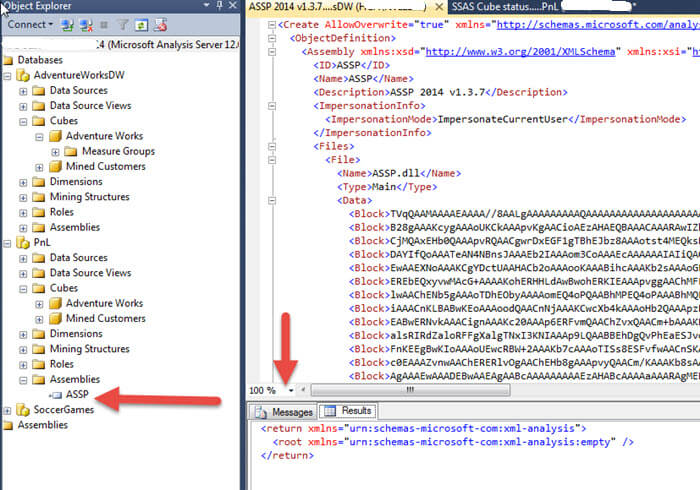
To create, update or delete local cubes, you must write and execute either an ASSL script or an AMO program. Local cubes and local mining models allow analysis on a client workstation while it is disconnected from the network. For example, a client application might call the OLE DB for OLAP 9.0 Provider (MSOLAP.3), which loads the local cube engine to create and query local cubes, as shown in the following illustration: ADMOD.NET and Analysis Management Objects (AMO) also load the local cube engine when interacting with local cubes. Only a single process can access a local cube file, because the local cube engine exclusively locks a local cube file when it establishes a connection to the local cube. With a process, up to five simultaneous connections are permitted. A.cub file may contain more than one cube or data mining model. Queries to the local cubes and data mining models are handled by the local cube engine and do not require a connection to an Analysis Services instance.
A connection to Tabular in Excel is a connection to Analysis Services. The Excel wizard does not allow creating a connection including a DAX query, but with a simple change in the ODC file generated by the wizard, you can transform a connection to a cube into a DAX query that returns data in an Excel table. Server: Please specify the instance name to connect with Microsoft Analysis Services. Local Cube File: If the Cube file is in your file system then select this option. Enter information to log on to the server: Use this section to decide how you want to connect with Microsoft Analysis Services.
Source for data for local cube Creation method Server-based cube You can use either the CREATE GLOBAL CUBE statement or an Analysis Services Scripting Language (ASSL) script to create and populate a cube from a server-based cube. For more information, see. Relational data source You use an ASSL script to create and populate a cube from an OLE DB relational database. To create a local cube using ASSL, you simply connect to a local cube file (.cub) and execute the ASSL script in the same manner as executing an ASSL script against an Analysis Services instance to create a server cube. For more information, see. Use the REFRESH CUBE statement to rebuild a local cube and update its data.
Ssas Cube Refresh
For more information, see. Local Cubes Created from Server-based Cubes.
When creating local cubes created from server-based cubes, the following considerations apply:. Distinct count measures are not supported. When you add a measure, you must also include at least one dimension that is related to the measure being added. For more information about dimension relationships to measure groups, see. When you add a parent-child hierarchy, levels and filters on a parent-child hierarchy are ignored and the entire parent-child hierarchy is included. Member properties are not created. When you include a semi-additive measure, no slices are permitted on either the Account or the Time dimension.
Ssa File Extension

Reference dimensions are always materialized. When you include a many-to-many dimension, the following rules apply:. You cannot slice the many-to-many dimension. You must add a measure from the intermediary measure group. You cannot slice any of the dimensions common to the two measure groups involved in the many-to-may relationship. Only those calculated members, named sets, and assignments that rely upon measures and dimensions added to the local cube will appear in the local cube.
Invalid calculated members, named sets, and assignments will be automatically excluded. In order for a user to create a local cube from a server cube, the user must be granted Drillthrough and Local Cube permissions on the server cube. For more information, see. Local cubes are not secured using roles like server cubes.
Ssa File An Application
Anyone with file-level access to a local cube file can query cubes in it. You can use the Encryption Password connection property on a local cube file to set a password on the local cube file. Setting a password on a local cube file requires all future connections to the local cube file to use this password in order to query the file.